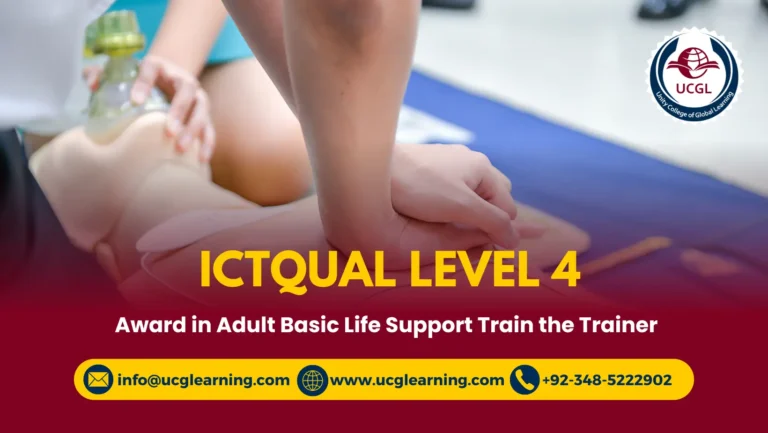ICTQual Level 4 Award in Moving and Handling Train the Trainer
In workplaces where physical tasks are routine, ensuring the safety of both employees and clients is paramount. The Level 4 Award in Moving and Handling Train the Trainer stands as a cornerstone in fostering a culture of safety and competence. This course not only equips individuals with essential skills in moving and handling but empowers them to pass on this knowledge effectively.
Course Introduction:
The Level 4 Award in Moving and Handling Train the Trainer is designed to provide participants with the expertise to deliver comprehensive training in safe moving and handling practices. From understanding ergonomic principles to mastering manual handling techniques, this course covers a range of topics essential for promoting workplace safety and preventing injuries.
Course Benefits:
- Enhanced Safety: Participants gain the knowledge and skills needed to mitigate risks associated with moving and handling tasks, reducing the likelihood of workplace accidents and injuries.
- Empowered Trainers: The course not only focuses on developing proficiency in moving and handling techniques but also hones participants’ ability to deliver engaging and effective training sessions to others.
- Compliance: By becoming certified trainers, participants contribute to ensuring compliance with health and safety regulations and organizational policies regarding moving and handling practices.
Course Study Units:
The curriculum of the Level 4 Award in Moving and Handling Train the Trainer is structured to cover essential aspects of safe moving and handling. Key study units include:
- Fundamentals of Moving and Handling
- Anatomy and Physiology of Movement
- Risk Assessment and Hazard Identification
- Ergonomic Principles and Equipment
- Safe Lifting and Handling Techniques
- Training Design and Delivery
- Assessment and Feedback
- Legal and Ethical Considerations
- Continuous Professional Development
Learning Outcomes:
Fundamentals of Moving and Handling:
- Understand the basic principles and importance of safe moving and handling practices in the workplace.
- Identify common hazards and risks associated with manual handling tasks.
- Recognize the impact of poor moving and handling techniques on individual health and safety.
Anatomy and Physiology of Movement:
- Describe the structure and function of the musculoskeletal system involved in movement.
- Explain how muscles, bones, and joints work together to facilitate safe and efficient movement.
- Identify factors that can affect an individual’s ability to move and handle objects safely.
Risk Assessment and Hazard Identification:
- Conduct comprehensive risk assessments of workplace environments and manual handling tasks.
- Identify potential hazards and ergonomic risks associated with specific tasks and work settings.
- Prioritize hazards based on severity and likelihood of occurrence and develop control measures to mitigate risks.
Ergonomic Principles and Equipment:
- Understand ergonomic principles and how they apply to the design of work environments and equipment.
- Evaluate the effectiveness of ergonomic solutions in reducing the risk of musculoskeletal injuries.
- Select appropriate assistive devices and equipment to support safe moving and handling practices.
Safe Lifting and Handling Techniques:
- Demonstrate proper lifting, carrying, and handling techniques to minimize the risk of injury.
- Apply biomechanical principles to optimize body mechanics and reduce strain on muscles and joints.
- Recognize factors that may require modifications to lifting and handling techniques based on individual capabilities and task requirements.
Training Design and Delivery:
- Develop engaging and informative training programs on moving and handling practices tailored to the needs of diverse audiences.
- Utilize a variety of teaching methods and instructional aids to enhance participant understanding and retention.
- Organize training sessions effectively, including scheduling, venue selection, and resource allocation.
Assessment and Feedback:
- Establish objective criteria to assess participants’ competency in moving and handling techniques.
- Provide constructive feedback to participants based on their performance during practical demonstrations and simulations.
- Identify areas for improvement and offer targeted interventions to support ongoing skill development.
Legal and Ethical Considerations:
- Understand legal responsibilities and obligations related to moving and handling practices, including relevant health and safety legislation.
- Recognize ethical considerations regarding duty of care, confidentiality, and respect for individual rights and dignity.
- Ensure compliance with organizational policies and procedures and maintain accurate records of training activities.
Continuous Professional Development:
- Recognize the importance of lifelong learning and professional growth in maintaining competence as a moving and handling trainer.
- Engage in ongoing education and training opportunities to stay abreast of advances in ergonomic principles, equipment, and best practices.
- Pursue certifications, memberships, and other professional development activities to enhance credibility and expertise in the field of moving and handling.
Who is This Course For?
The Level 4 Award in Moving and Handling Train the Trainer is suitable for individuals who are responsible for training and supervising others in moving and handling practices within various industries. This includes:
- Health and social care professionals
- Occupational health and safety practitioners
- Human resources and training professionals
- Caregivers and support workers
- Anyone involved in manual handling tasks or responsible for the safety of others in the workplace
Future Progression for This Course:
Completion of the Level 4 Award in Moving and Handling Train the Trainer opens avenues for career advancement and professional development. Graduates may choose to:
- Pursue further qualifications or certifications in related fields, such as health and safety management or ergonomic assessment.
- Expand their scope of practice by delivering training in other areas of health and safety or workplace compliance.
- Consult with organizations to develop and implement comprehensive moving and handling policies and procedures.
- Advocate for continuous improvement in moving and handling practices and contribute to creating safer and healthier work environments.
Level 4 Award in Moving and Handling Train the Trainer serves as a catalyst for fostering a culture of safety and responsibility in the workplace. By empowering individuals to become proficient trainers in moving and handling practices, this course plays a pivotal role in reducing workplace injuries and promoting the well-being of employees and clients alike. Let’s strive together to create safer, healthier, and more productive workplaces for everyone.







